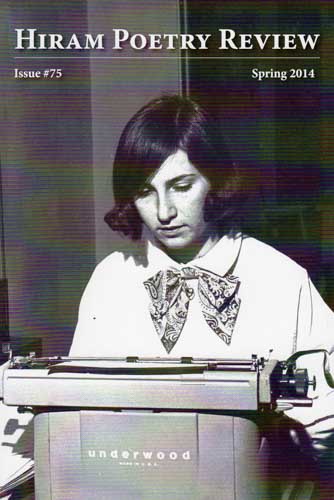Hiram Poetry Review – Spring 2014
Whether written in traditional free verse or veering off into experimental territory, the poems in the latest issue of theHiram Poetry Review are frank, high-spirited, and self-assured. Featuring twenty-one poems from nineteen different poets, this slim volume benefits from a clear editorial vision favoring “poems that exhibit excellence with flaws rather than general competence.” Whether written in traditional free verse or veering off into experimental territory, the poems in the latest issue of theHiram Poetry Review are frank, high-spirited, and self-assured. Featuring twenty-one poems from nineteen different poets, this slim volume benefits from a clear editorial vision favoring “poems that exhibit excellence with flaws rather than general competence.” Even if a certain amount of brashness preempts nuance in several of the issue’s poems, the urgency of the speakers and their subject matter never fail to command attention. However, the best poems from the issue manage to be both urgent and nuanced, gathering self-assuredness from the poets’ careful attention to how syntax and diction compliment the scope and ambition of their subject matter.
Perhaps the most evocative pairing of language and subject matter was Matthew Dulany’s poem “Yes,” in which the indelible roadside scenes that have always marked a son’s way home take on added significance as he returns to visit his dying father. Fixtures of the landscape which formerly reassured the speaker become a disarming metaphor for the physical decline that occurs in our absence. The breezy music of Dulany’s lines nicely captures the swift, insular feeling of highway travel and creates an odd tension with the fixity of the sober scene awaiting him:
Always there’s a station where the gas
is pennies cheaper, where the air is free,
where tractor trailers whirring past
appeal to thoughts of temporality.
Always the pike led to the turnpike,
always that abandoned ferry’s rusting shell lay off to the right,
beached on the Raritan’s unclean bank—
the ghost ferry, I called it.
Hello, Ghost Ferry.
Polly Buckingham’s “Your Big Toe” was another of the issue’s well-executed poems. To paraphrase Shakespeare, repressed sexual energy will out, and it does so in entertainingly askew fashion in Buckingham’s poem, as her speaker considers the meaning of a dream and its unshakeable image of a prospective mate’s “ridged and uneven” big toe nail seen by campfire light. The combination of the sexualized image and the description of the action it provokes is played for just the right amount of melodrama before the poem’s speaker interjects with a frank admission:
After four days of frantic hiking
my big toenail turns black—
smashing against the boot uphill and down
driven by visions
of your toe
and the darkness outside the fire
where I search for you and come up empty.
I stumble down a rocky trail. Let’s be honest:
Your big toe turns me on.
Several of the more avant-garde poems in the issue offer experiments in form. Jonathan Greenhause’s poem “Edward’s Indecisiveness” appropriates the form of a multiple-choice test to playfully chronicle the biographical roots of Edward’s titular flaw. Stephen Brown creates a subheading style all his own in his rhythmic, self-cannibalizing poems about alienation and city life.
For his part, Richard Kostelanetz uses what looks to be an amalgam of computer code, obscure symbols, and mathematics in the excerpt from his work AN EPIC POEM FOR THE 21ST CENTURY. Though I can’t feign authority regarding what the hell is going on in the poem, I can say that I enjoyed speculating about it. Is Kostelanetz making a statement about the status of science and mathematics in contemporary culture by suggesting a comparison with the great epic poems of the past? Is he celebrating or lamenting the cultural artifacts that have been replaced by technological innovation? Is this just a concrete poem? Is my brain made of concrete? All fair enough questions to bandy about. Whatever your interpretation, the enigmatic formal experiments of these three poets nicely extend the poetic range of the journal while providing the bold individuality that’s such a hallmark of the issue’s poetry as a whole.
While a good deal of the poems in this issue of Hiram Poetry Review were polished and propulsive, the two book reviews lacked focus, failing to properly frame or illuminate the works under consideration. In the review of Marjorie Maddox’s new poetry collection Local News from Someplace Else, excerpts from Maddox’s poetry seemed to function as garnish for the reviewer’s own sermonizing, while an argument about accessibility versus triviality and the critical bias against the publishing house McSweeney’s drags on for roughly two and a half pages in the review of Dan Chelotti’s debut poetry collection x, which causes the context in which the book was released to feel like it received more thorough consideration than the contents of the book. For reviews of this length, the discussions of structure, themes, and craftsmanship were scattershot, leaving the reader with a rather vague impression of each poet’s work.
Minor reservations aside, the Hiram Poetry Review still manages to cut a distinctive figure in the poetry world after nearly a half century in publication because of its charismatic blend of the accessible and avant-garde. Rather than attempting to be encyclopedic and ending up uneven, the Hiram Poetry Reviewmakes a virtue of its brevity, selecting experiments worth lingering over and voices worth listening to.
[hirampoetryreview.wordpress.com]





